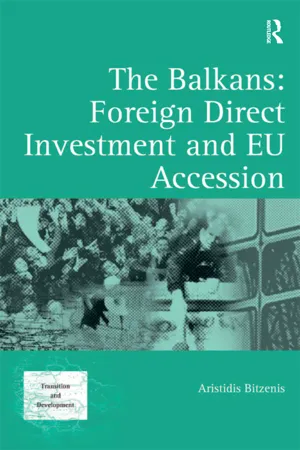Marketing
Direct investment
Direct investment refers to the acquisition of a controlling interest in a company or business entity by a foreign investor. This involves a substantial level of influence and control over the operations and management of the invested entity. Direct investment typically entails a long-term commitment and can involve various forms such as mergers, acquisitions, and establishing new facilities.
Written by Perlego with AI-assistance
4 Key excerpts on "Direct investment"
Learn about this page
Index pages curate the most relevant extracts from our library of academic textbooks. They’ve been created using an in-house natural language model (NLM), each adding context and meaning to key research topics.
- Aristidis Bitzenis(Author)
- 2016(Publication Date)
- Routledge(Publisher)
The choice of a market entry strategy is a critical part of international business strategy. Companies employ special modes to cope with international markets that differ in the control that the entrant attains over the local operations and in the resources required for the entry. Firms entering a foreign market can choose between an array of possible organizational modes. Foreign involvement looks at different lucrative ways of expanding operations, or at different capital generating activities in a foreign country.There are five general entry modes in the economic activities of a foreign country. The first one is trading, either importing from or exporting to (directly or indirectly) a foreign country. Two other ways are foreign Direct investment (FDI) and indirect (portfolio) investments. Portfolio investment is merely the transfer of money capital that allows the investor to participate in the earnings of a company.Figure 3.1 Foreign involvement using entry modesSource : Bitzenis, 2008, 198 (revised version).Foreign Direct investment is differentiated due to the intent of the investor. In portfolio investment the goal is short-term, focused on the quick increase in the money capital of the investor with no intention of interfering in ownership rights, management and voting equity. In Direct investment, the primary goal is the beneficial influence (enlargement of market share, elimination of competition, strategic alliance, etc.) of the investment to the investor-company, which should eventually lead to increased profits. Another difference between the two is the percentage of the financial capital involvement. What is considered as FDI is different throughout the world due to different regulations concerning the percentage of ownership in the operations in question. However, there is a commonly accepted definition of FDI as shown in Figure 3.1 .The most common ways of undertaking an FDI project are: 1) Wholly owned subsidiary100% ownership of the assets by a single company. This involves the internal transfer of capital, technology, know-how and rights to production from the parent firm to the subsidiary and full ownership of the subsidiary by the parent firm.- eBook - ePub
- Sally Dibb, Lyndon Simkin(Authors)
- 2007(Publication Date)
- Routledge(Publisher)
A marketer may concentrate solely on the domestic home market: domestic marketing. The company may seek out opportunities for selling its existing products outside of its domestic market through exporting: export marketing. International marketing is the reduced reliance on intermediaries and the direct involvement in countries in which trade takes place. Multinational marketing involves greater modification of the company's marketing mix to take account of cultural and taste differences in target markets outside the domestic market. Global marketing is the extreme, where companies recognize the need to establish operations in non-domestic markets, requiring significant investment and the understanding of business practices in these countries.According to Bradley, the corporate context of international marketing involves understanding how the business responds to environmental opportunities and threats in markets of very different configurations and underlying behaviour to ‘home’ markets. Bradley states that, ‘international marketing processes and decisions require the firm to identify needs and wants of customers, to produce assets [products or services] to give a differential marketing advantage, to communicate information about these assets and to distribute and exchange them internationally through one or a combination of exchange modalities’, outside the organization's domestic market. There is a straightforward process for internationalization: (a) the decision by a business to internationalize; (b) analysis of the international marketing environment; (c) entering international markets through one or more entry strategy options; (d) the development of associated international marketing mix programmes; and (e) the implementation and control of the international marketing strategy and programme.A core task for the marketer addressing international markets is the understanding of the international marketing environment (cf. Brief 4 - eBook - ePub
New Trends in Process Control and Production Management
Proceedings of the International Conference on Marketing Management, Trade, Financial and Social Aspects of Business (MTS 2017), May 18-20, 2017, Košice, Slovak Republic and Tarnobrzeg, Poland
- Lenka Štofová, Petra Szaryszová, Lenka Štofová, Petra Szaryszová(Authors)
- 2017(Publication Date)
- CRC Press(Publisher)
International trade is the exchange of goods and services across international borders and is also known as exports and imports. Exports are goods and services produced by a firm in one country and then sent to another country. Imports are goods and services produced in one country and brought in by another country. International trade refers to exchange of products and services across national borders, typically through exporting and importing. Exporting is the sale of products or services to customers located abroad, from a base in the home country or a third country. Importing or global sourcing refers to procurement of products or services from foreign suppliers for consumption in the home country or a third country (Štofová & Szaryszová 2016). International investment refers to international transfer or acquisition of ownership in assets. Foreign Direct investment is an internationalization strategy in which the firm establishes a physical presence abroad through acquisition of productive assets such as capital, technology, labor, land, plant, and equipment.Simply international market is the application of marketing principles to more than one country. According to the American Marketing Association the “international marketing is a multinational process of planning and executing the conception, put price, promotion and distribution of ideas, goods and services to create exchanges that satisfy individual and organizational objectives.”2 WHAT DOES “GOING WORLDWIDE” MEAN? Going international in any field of endeavour provides organizations with exciting new opportunities for growth as well as challenges;– Cost management strategy must be of concern for going international. Moving into new territories require new organizational structures, which decentralizes operations. Training of new staff to abreast them with organizational objectives, investing in technology to ensure business operations stay on schedule all requires effective cost management. - eBook - ePub
Managing the Internationalization Process (Routledge Revivals)
The Swedish Case
- Mats Forsgren(Author)
- 2015(Publication Date)
- Routledge(Publisher)
Chapter three Foreign Direct investment theory and the internationalization of Swedish industry IntroductionThe starting-point in what is usually called foreign Direct investment theory lies in a company’s capability to invest abroad. The prime qualification is assumed to be an asset of some kind which the company has and is in the best position to exploit. The reason why this starting-point is chosen pertains to the existence of a sharp division between home market and overseas market in respect of the knowledge possessed by the company. The company which invests abroad is assumed to have a far poorer knowledge of overseas markets than of its own home market. Strictly speaking, the reasons for this and the significance thereof have been surprisingly little analysed in theory but are usually related to factors such as language, cultural differences, geographical distance, etc. These factors, it is alleged, place the foreign investor at a disadvantage vis-à-vis his local competitors, who are more cognizant of market conditions and rules of play and speak the same language as the customers (Hood and Young, 1979).This disadvantage must therefore be outweighed by an asset possessed by the overseas investor but not the local competitors. How otherwise could Direct investments be made at all? Since Direct investments, at least in the industrialized world, seem to be made in both directions relative to national frontiers this asset has gradually come to be associated with the individual company rather than the country in which it is based. The individual company controls an asset which enables it to compete with local firms in an overseas market.Foreign Investment as an Effect of Market ImperfectionWith this as starting-point Direct investment theory was then developed in two different directions. The older one is forever associated with Kindleberger and Hymer’s analyses of the rise of multinational companies (Kindleberger, 1969; Hymer, 1976). On the basis of Bain’s analysis of the characteristics of different forms of market and industries (Bain, 1959) Kindleberger and Hymer describe the company-specific advantages as a manifestation of market imperfections or monopolistic benefits. According to this view the incidence of market imperfections is a prerequisite for the generation of such advantages. Moreover, better functioning markets, both factor markets and output markets, would automatically involve a reduced volume of foreign Direct investment, since the monopolistic advantages would not then exist to the same extent (Swedenborg, 1979: 39). Hymer and his followers maintain that it is companies in oligopolistic industries which make foreign Direct investments. For these industries are characterized by high barriers to entry for the companies which would wish to begin production, at the same time as the companies within the industry are heavily dependent on, and watch each other’s behaviour. But these companies have above all a competitive advantage which others lack, on which they can base their activities in a market other than the domestic (Kindleberger, 1969; Hymer, 1976; and Calvet, 1981). Caves further specified the ‘oligopolistic’ explanation of Direct investments by distinguishing between homogeneous and differentiated oligopoly. While the homogeneous oligopolies, consisting of comparatively few companies but with the same kind of product, are responsible chiefly for vertical investments abroad (the forestry industry can serve as an example), the differentiated oligopolies answer for horizontal investments. In Caves’ opinion product differentiation on the home market constitutes the principal base for foreign investments. A company which succeeds in differentiating its product in the home market, and furthermore faces limited competition by reason of high barriers to entry for outsiders, controls an asset, primarily in the form of knowledge, which can be used without heavy extra costs on the overseas markets (Caves, 1971).



